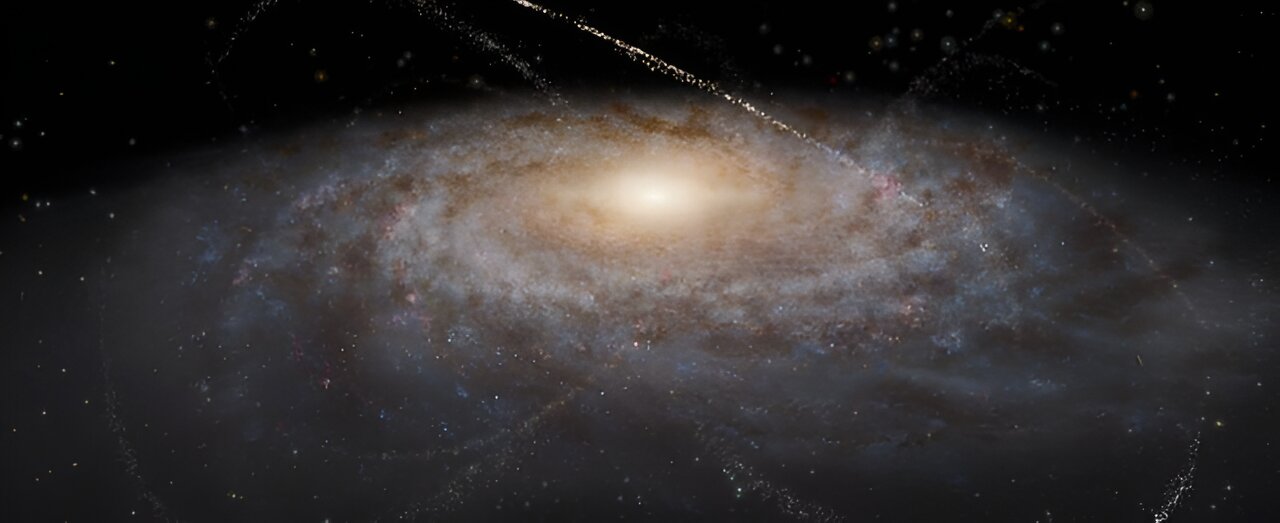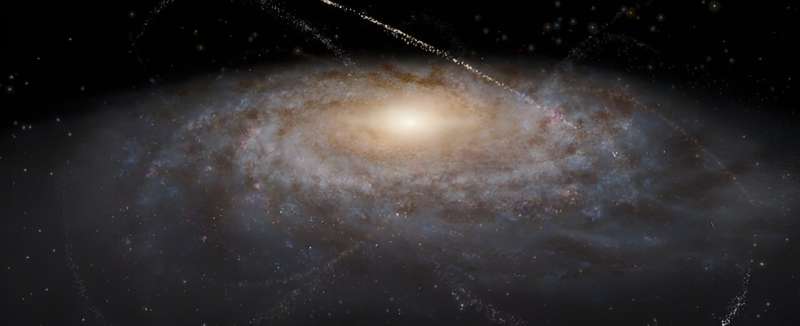

Glittering threads of stars around the Milky Way may hold answers to one of our biggest questions about the universe: what is dark matter? With images taken through six different color filters mounted to the largest camera ever built for astronomy and astrophysics, Vera C. Rubin Observatory’s upcoming Legacy Survey of Space and Time will reveal never-before-seen stellar streams around the Milky Way—and the telltale effects of their interactions with dark matter.
As mesmerizing as rivers that glitter in the sunlight, stellar streams trace sparkling arcs through and around our home galaxy—the Milky Way. Stellar streams are composed of stars that were originally bound in globular clusters or dwarf galaxies but have been disrupted by gravitational interactions with our galaxy and drawn into long, trailing lines.
These slender trails of stars often show signs of disturbance, and scientists suspect that, in many cases, dark matter is the culprit. Vera C. Rubin Observatory will soon provide a wealth of data to illuminate stellar streams, dark matter, and their complex interactions.
Dark matter makes up 27% of the universe, but it can’t be observed directly, and scientists currently don’t know exactly what it is. To learn more, they use a variety of indirect methods to investigate its nature. Some methods, like weak gravitational lensing, map the distribution of dark matter on large scales across the universe. Observing stellar streams allows scientists to probe a different aspect of dark matter because they showcase the fingerprint of dark matter’s gravitational effects at small scales.
Vera C. Rubin Observatory, located in Chile, will use an 8.4-meter telescope equipped with the largest digital camera in the world to conduct a 10-year survey of the entire southern hemisphere sky beginning in late 2025. The resulting data, with images taken through six different color filters, will make it easier than ever for scientists to isolate stellar streams among and beyond the Milky Way and examine them for signs of dark matter disruption.
“I’m really excited about using stellar streams to learn about dark matter,” said Nora Shipp, a postdoctoral fellow at Carnegie Mellon University and co-convener of the Dark Matter Working Group in the Rubin Observatory/LSST Dark Energy Science Collaboration. “With Rubin Observatory, we’ll be able to use stellar streams to figure out how dark matter is distributed in our galaxy from the largest scales down to very small scales.”
Rubin Observatory will begin science operations in late 2025. Rubin Observatory is a Program of NSF NOIRLab, which, along with SLAC National Accelerator Laboratory, will jointly operate Rubin.
Evidence suggests that a spherical halo of dark matter surrounds the Milky Way, made up of smaller dark matter clumps. These clumps interact with other structures, disrupting their gravitational dynamics and changing their observed appearance. In the case of stellar streams, the results of dark matter interactions appear as kinks or gaps in the starry trails.
Rubin Observatory’s incredibly detailed images will make it possible for scientists to identify and examine very subtle irregularities in stellar streams and thus infer the properties of the low-mass dark matter clumps that caused them—even narrowing down what types of particles these clumps are made of.
“By observing stellar streams, we’ll be able to take indirect measurements of the Milky Way’s dark matter clumps down to masses lower than ever before, giving us really good constraints on the particle properties of dark matter,” said Shipp.
Stellar streams in the outer regions of the Milky Way are especially good candidates for observing the effects of dark matter because they’re less likely to have been affected by interactions with other parts of the Milky Way, which can confuse the picture. Rubin Observatory will be able to detect stellar streams at a distance of about five times farther than we can see now, allowing scientists to discover and observe an entirely new population of stellar streams in the Milky Way’s outer regions.
Stellar streams are challenging to distinguish from the many other stars of the Milky Way. To isolate stellar streams, scientists search for stars with specific properties that indicate they likely belonged together as globular clusters or dwarf galaxies. They then analyze the motion or other properties of these stars to identify those connected as a stream.
“Stellar streams are like strings of pearls, whose stars trace the path of the system’s orbit and have a shared history,” said Jaclyn Jensen, a Ph.D. candidate at the University of Victoria who plans to use Rubin/LSST data for her research on the progenitors of stellar streams and their role in the formation of the Milky Way.
“Using properties of these stars, we can determine information about their origins and what kind of interactions the stream may have experienced. If we find a pearl necklace with a few scattered pearls nearby, we can deduce that something may have come along and broken the string.”
Rubin Observatory’s 3200-megapixel LSST Camera is equipped with six color filters—including, notably, for stellar stream scientists like Shipp and Jensen, an ultraviolet filter. Rubin’s ultraviolet filter will provide critical information on the blue-ultraviolet end of the light spectrum that will enable scientists to distinguish the subtle differences and untangle the stars in a stream from look-alike stars in the Milky Way.
Overall, Rubin will provide scientists with thousands of deep images taken through all six filters, giving them a clearer view of stellar streams than ever before.
The avalanche of data that Rubin will provide will also inspire new tools and methods for isolating stellar streams. As Shipp notes, “Right now it’s a labor-intensive process to pick out potential streams by eye—Rubin’s large volume of data presents an exciting opportunity to think of new, more automated ways to identify streams.”
Provided by
National Science Foundation
Citation:
Rubin observatory will reveal dark matter’s ghostly disruptions of stellar streams (2024, April 15)
retrieved 15 April 2024
from https://phys.org/news/2024-04-rubin-observatory-reveal-dark-ghostly.html
This document is subject to copyright. Apart from any fair dealing for the purpose of private study or research, no
part may be reproduced without the written permission. The content is provided for information purposes only.